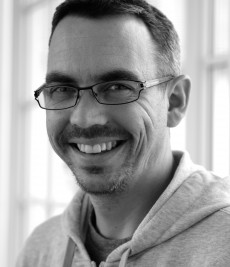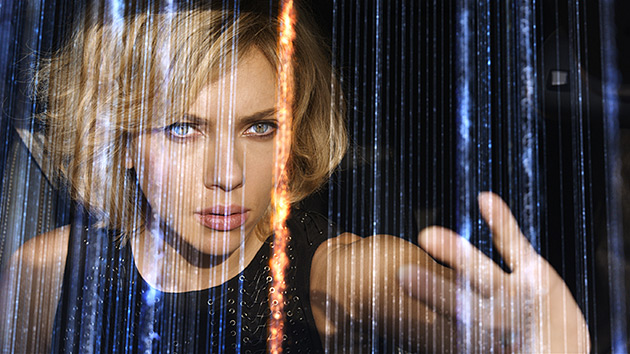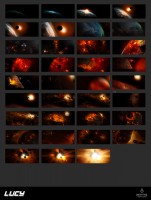
ILM Tapped Raw Talent Around the World to Solve Design Problems on Luc Besson's Ambitious Sci-Fi Opus
Director Luc Besson’s latest film stars Scarlett Johansson as Lucy, an unwilling drug mule who discovers she’s carrying a package of a blue crystalline drug inside her tummy. When it leaks, the story begins in earnest. The drug turns Lucy into a super warrior. Her intelligence is off the charts. She can walk on walls, shoot light from her mouth, do just about anything except fly.
Few films have generated such extreme reactions as has Lucy. Reviews range from Time magazine’s Richard Corliss who writes, “Lucy tops its only competition … as the summer’s coolest, juiciest, smartest action movie,” to The Atlantic’s Christopher Orr who grumps, “Every now and then a movie comes along that’s so beyond-the-pale sloppy, so disastrous in both conceit and execution, that it simply defies conventional analysis.”
The consensus among top critics on Rotten Tomatoes tips slightly toward the positive pole, giving the film a 61 percent approval rating. But at the box office on opening weekend, Lucy ruled with $44 million in ticket sales.
To show how the leaked drug affects her, artists from Industrial Light & Magic along with those from Rodeo FX created a psychedelic smorgasbord of crazy cool visual effects. Lucy grows extra hands, her face disintegrates into a hundred thousand multi-colored particles, she reaches inside a drug lord’s memory, sprouts tentacles that absorb a bank of computers, and travels inside her own drug-expanded memory – all the way back to the beginning of time. And, that’s but a sample.
Nicholas Brooks, who received a visual effects Oscar for What Dreams May Come, was senior visual effects supervisor on Lucy. Richard Bluff was visual effects supervisor at ILM. François Dumoulin supervised effects at Rodeo FX, where artists created a surreal car chase.
“Once Nick [Brooks] got a flavor of the project from Luc Besson, he called ILM,” Bluff says. “He wanted us to take on the vast majority of the heavy design work. The interesting thing that happened then was that John Knoll [chief creative officer at ILM] brought 15 of our supervisors into a room to look at the sequences and give their opinion on what they saw and how we could tackle the project.”
Brooks and Besson had supplied previs for a few sequences, including one of Lucy sprouting the black tendrils, reference videos, and a script that included a scene showing the creation of the universe in reverse at great speed.
“The beauty of ILM is that we’re a huge, huge machine,” Bluff says. “But, this was an incredibly design-oriented project compared to much of the work we do. So the meeting was about how we could change the way we work to tackle this project because everybody was enthusiastic about working with Luc Besson.”
Bluff had come to ILM in 2003 after a 3-year stint at Blur Studio and a previous three years working as a lead digital artist at Revolution Software, an adventure game developer in York, England. At ILM, he became a digital matte supervisor for Transformers in 2007. Among the films to his credit are Avatar, Iron Man 2, Cloud Atlas, Elysium, and three more Transformers films. His work in the generalist department creating digital matte environments has resulted in five VES nominations and a VES award for creating midtown Manhattan in The Avengers. Although he had not worked on a film as a visual effects supervisor or associate vfx supe, this film’s unique effects fit his experience.
“I had managed the generalist department for seven years, so I had unique insight into certain skill sets,” he says. “Like a lot of people in the room, I felt we needed to tap into the commercial world a little bit, and try to find raw talent around the world trying to solve some of these design problems. I have hired people from game companies, people who worked on commercials, people from boutique effects companies. I’ve taken people straight out of school and been involved in their training. I’ve found people all over the world in all walks of life: Photographers, architects, artists. We have phenomenal artists here at ILM who can contribute across the board, and we wanted to harness their opinions. But, we also wanted to try something different. I felt like I knew what we needed to do.”
Bluff began working on the project in July, 2013. Conveniently, while he was prepping for Lucy he was running the apprenticeship program at ILM, which brought select young artists into the studio for an eight-week boot camp.
“I think this is part of the reason ILM felt I was the right person for the show,” he says. “For the previous six months, I had traveled to schools around the US looking for new young talent. We brought five people into the paid apprenticeship program, and at the end of the process, placed four of them on shows.”
Three of the four former students went to work for Bluff on Lucy and one, Cody Gramstad, created most of the concept art for the show.
“As soon as I saw the work coming in on Lucy, I knew Cody would be perfect,” Bluff says. “I had pulled him straight out of school a month earlier. He had no idea how the industry works. No idea how clients looked at artwork. No idea how things should be presented. And that was the beauty of it. I didn’t want someone drawing with limitations in mind. He just made awesome images. We picked the ones that told the right story, showed them to Luc [Besson], and he loved it.”
During prep, Bluff also began exploring the reference materials Brooks and the art department at Besson’s Europacore had created. Then he looked for new approaches.
“Nick’s reference was from the real world,” Bluff says. “He had beautiful macro photography from inside the body, for example. That was perfect. I understood what they were looking for. So, I tried to solve the unique problems. I looked for examples in the CG realm, in TV commercials, in game cinematics. I even looked at the psychedelic displays you see behind DJ’s at raves.”
When Besson told Bluff he liked the introduction to director David Fincher's version of The Girl with the Dragon Tattoo, Bluff called Jennifer Miller, the creative director at Blur Studio, which had created the title sequence.
“I asked her for names of freelancers she uses,” Bluff says. “I couldn’t tell her anything about this project, obviously, but I asked her to send me to the strangest, weirdest, most wonderful places on the web she could think of. After going down all those avenues, I realized very quickly that two or three led to the same person: Matthias Müller.”
Müller, a German visual effects artist (matthiasm.de) with a string of commercials to his credit, works with 3ds max, particle flow, Krakatoa, Frost, FumeFX, and Vray.
“Matthias does a lot of particle work that I would call effects concepting more than real shot production,” Bluff says. “And he works in [Autodesk 3ds] max, which is the tool of choice in the generalist department at ILM. I gathered a lot of his work and everything else I found and created a little mini-reel to show to Luc. I had work from lots of artists here at ILM. People here were really into the project and some did experiments and tests.”
Among the work he showed to Besson were examples of Müller’s art.
“Luc fell in love with our big bang designs and Matthais’s work, so one of the first things we did was to hire Matthias,” Bluff says. “He remained a freelance artist – he stressed that he wasn’t a production artist. And that was fine with me. I didn’t want him thinking about the big picture. I’d just throw him ideas – create a vortex, a nebula that feels like a jellyfish, an explosion in zero gravity. Cody [Gramstad] and Matthias fired off each other. Cody would do concepts. Matthias would do effects. And vice versa. And then the artists at ILM hammered Matthias’s files into shape.”
A second freelance artist also became integral to the project, thanks to Nicholas Brooks. The artist, Perry Hall, had worked on the painted world sequences in What Dreams May Come. From his studio in Massachusetts, Hall creates what he calls “Live Paintings” and “Sound Drawings.” (www.lovebrain.net)
“Perry creates art with liquids, paints, and different chemicals,” Bluff says. “Imagine how oil and water repel each other. Then, imagine playing a bass guitar through the liquid so those vibrations repel each other at a different rate. Perry shoots this on his HD camera and projects the video on a wall, makes prints, displays projects in art galleries, projects on the sides of castles with music. When I saw his work, I knew we could use his images all over the movie.”
The effects team composited Hall's images into Lucy’s eyes, inside Wang’s brain, and along the edge of the universe during Lucy’s out of body time-traveling experience.
“We knew that Luc [Besson] wanted to see echoes throughout the project; visual cues that remind you of something you’d seen in the past,” Bluff says. “So we used Perry’s painting elements to deepen those visual cues.”
Each day, the crew would show Besson artwork and designs for his approval. Besson would travel to ILM. And Bluff even made a trip to Paris to meet with the director and present the team’s idea for the creation of the earth.
“Cody [Gramstad], Daniel Ferreira [CG supervisor], and I came together and developed an idea that included an eclipse moment with the moon and the idea of seeing Tangier reform as we pan across the earth,” Bluff says. “Luc had these phrases I’ll always remember. He’d say in his French accent, ‘As you wish. I love it.’ Everyone kept fingers crossed that he’d say it, and he did. We suggested the idea and he said, ‘As you wish. I love it.’ It was a phenomenal experience working with him.”
Some sequences had tighter direction, but even so, Besson would approach the shots in unique ways. For example, ILM received black-and-white storyboards for a sequence in a plane during which Lucy looks in a mirror and hallucinates that her face melts and disintegrates.
“Luc came to ILM and sat down in our war room,” Bluff says. “He started riffling through all these papers in his satchel and pulled one out. He’d ripped a magazine page out of the in-flight magazine on the way over here. He slapped it down on the table and said, ‘I want you to base the airline sequence around this.’ It was an image of a person whose face was completely covered in sprinkles like you’d find on cupcakes.”
Sequence supervisor Ryan Hopkins developed the idea into shots that would have her skin bubble up on the surface, erode away, and reveal the sprinkles.
“The next time we saw Luc we said we had an idea for how we’d reveal the sprinkles,” Bluff says. “And he said, ‘I love it.’”
All told, ILM had less than 250 shots in the film, but a large number of sequences. Some sequences had six shots, some had 14, some had two. With that in mind, Bluff organized his crew of 40 into small teams who worked on individual sequences.
“We might have two technical directors and a compositor on one sequence, and one technical director and three compositors on another.”
The reverse birth of the universe sequence starts with Lucy in Times Square. Lucy stops time and then spreads her hands to reverse it. People in the foreground move so fast they become a blur while background buildings, all CG, shrink and change through one million frames. The team shot people against greenscreen at high frame rates. Through the sequence, the artists created 100 different skies with lighting to match.
“We had so much freedom to create,” Bluff says. “Everyone felt ownership over solving the problem and creating the designs. I think they all felt invested in trying to find out what Luc wanted and how far we could push this and how strange and weird and wonderful it could be. It was a unique project. Everyone had an opportunity to push their own creative ideas. It was hugely popular to work on.”
When Bluff finished with Lucy, it was back to digital matte painting – not the letdown you might imagine.
“It was a relief,” he laughs. “Someone tells me to paint a building pink, and that’s all I have to think about.”
However, that relief will be short-lived. Already, Bluff has taken on the job as associate visual effects supervisor on Unbroken. Lucy was a breakthrough project for a career about to take off in new, exciting directions. And chances are, he’ll love it.
Crafts: VFX/Animation
Sections: Creativity
Topics: Project/Case study blur studio cody gramstad ILM matthias müller nicholas brooks perry hall richard bluff siggraph 2014
Did you enjoy this article? Sign up to receive the StudioDaily Fix eletter containing the latest stories, including news, videos, interviews, reviews and more.

















Very strange, but quite enjoyable movie